tow PONTIAC GRAND PRIX 2005 Owner's Guide
[x] Cancel search | Manufacturer: PONTIAC, Model Year: 2005, Model line: GRAND PRIX, Model: PONTIAC GRAND PRIX 2005Pages: 444, PDF Size: 2.6 MB
Page 282 of 444
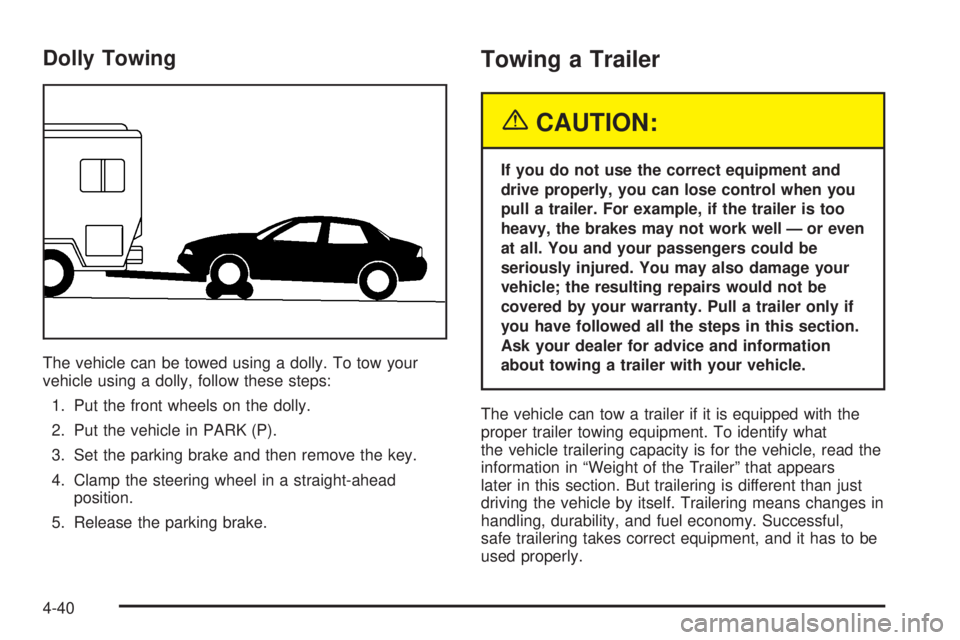
Dolly Towing
The vehicle can be towed using a dolly. To tow your
vehicle using a dolly, follow these steps:
1. Put the front wheels on the dolly.
2. Put the vehicle in PARK (P).
3. Set the parking brake and then remove the key.
4. Clamp the steering wheel in a straight-ahead
position.
5. Release the parking brake.
Towing a Trailer
{CAUTION:
If you do not use the correct equipment and
drive properly, you can lose control when you
pull a trailer. For example, if the trailer is too
heavy, the brakes may not work well — or even
at all. You and your passengers could be
seriously injured. You may also damage your
vehicle; the resulting repairs would not be
covered by your warranty. Pull a trailer only if
you have followed all the steps in this section.
Ask your dealer for advice and information
about towing a trailer with your vehicle.
The vehicle can tow a trailer if it is equipped with the
proper trailer towing equipment. To identify what
the vehicle trailering capacity is for the vehicle, read the
information in “Weight of the Trailer” that appears
later in this section. But trailering is different than just
driving the vehicle by itself. Trailering means changes in
handling, durability, and fuel economy. Successful,
safe trailering takes correct equipment, and it has to be
used properly.
4-40
Page 283 of 444
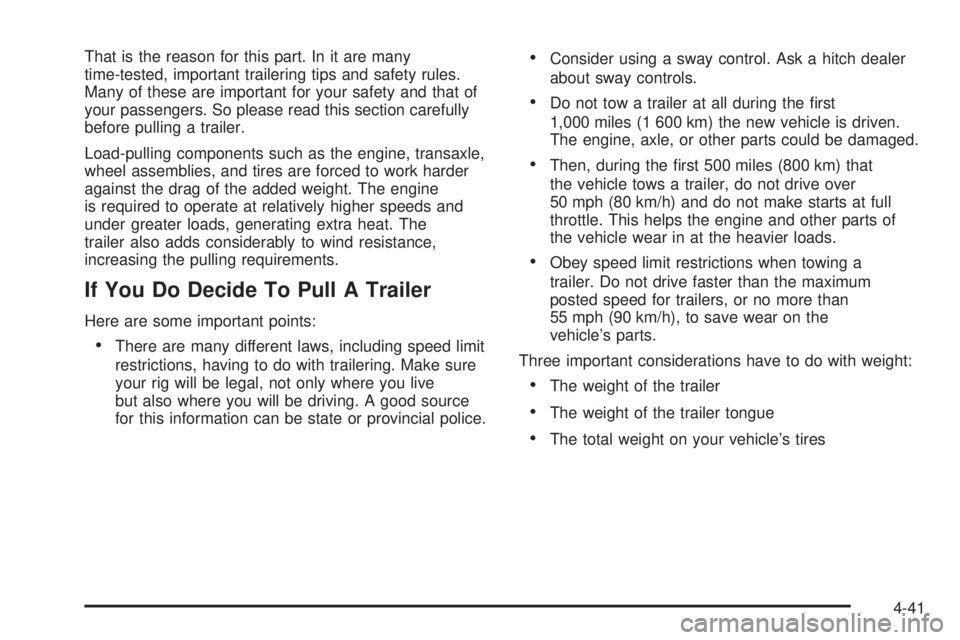
That is the reason for this part. In it are many
time-tested, important trailering tips and safety rules.
Many of these are important for your safety and that of
your passengers. So please read this section carefully
before pulling a trailer.
Load-pulling components such as the engine, transaxle,
wheel assemblies, and tires are forced to work harder
against the drag of the added weight. The engine
is required to operate at relatively higher speeds and
under greater loads, generating extra heat. The
trailer also adds considerably to wind resistance,
increasing the pulling requirements.
If You Do Decide To Pull A Trailer
Here are some important points:
There are many different laws, including speed limit
restrictions, having to do with trailering. Make sure
your rig will be legal, not only where you live
but also where you will be driving. A good source
for this information can be state or provincial police.
Consider using a sway control. Ask a hitch dealer
about sway controls.
Do not tow a trailer at all during the �rst
1,000 miles (1 600 km) the new vehicle is driven.
The engine, axle, or other parts could be damaged.
Then, during the �rst 500 miles (800 km) that
the vehicle tows a trailer, do not drive over
50 mph (80 km/h) and do not make starts at full
throttle. This helps the engine and other parts of
the vehicle wear in at the heavier loads.
Obey speed limit restrictions when towing a
trailer. Do not drive faster than the maximum
posted speed for trailers, or no more than
55 mph (90 km/h), to save wear on the
vehicle’s parts.
Three important considerations have to do with weight:
The weight of the trailer
The weight of the trailer tongue
The total weight on your vehicle’s tires
4-41
Page 284 of 444
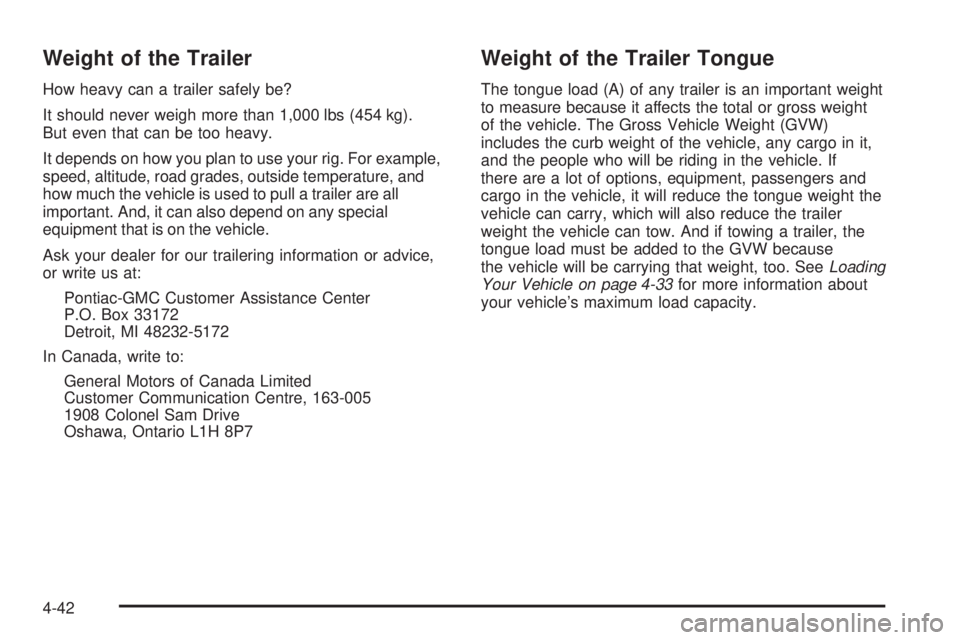
Weight of the Trailer
How heavy can a trailer safely be?
It should never weigh more than 1,000 lbs (454 kg).
But even that can be too heavy.
It depends on how you plan to use your rig. For example,
speed, altitude, road grades, outside temperature, and
how much the vehicle is used to pull a trailer are all
important. And, it can also depend on any special
equipment that is on the vehicle.
Ask your dealer for our trailering information or advice,
or write us at:
Pontiac-GMC Customer Assistance Center
P.O. Box 33172
Detroit, MI 48232-5172
In Canada, write to:
General Motors of Canada Limited
Customer Communication Centre, 163-005
1908 Colonel Sam Drive
Oshawa, Ontario L1H 8P7
Weight of the Trailer Tongue
The tongue load (A) of any trailer is an important weight
to measure because it affects the total or gross weight
of the vehicle. The Gross Vehicle Weight (GVW)
includes the curb weight of the vehicle, any cargo in it,
and the people who will be riding in the vehicle. If
there are a lot of options, equipment, passengers and
cargo in the vehicle, it will reduce the tongue weight the
vehicle can carry, which will also reduce the trailer
weight the vehicle can tow. And if towing a trailer, the
tongue load must be added to the GVW because
the vehicle will be carrying that weight, too. SeeLoading
Your Vehicle on page 4-33for more information about
your vehicle’s maximum load capacity.
4-42
Page 286 of 444
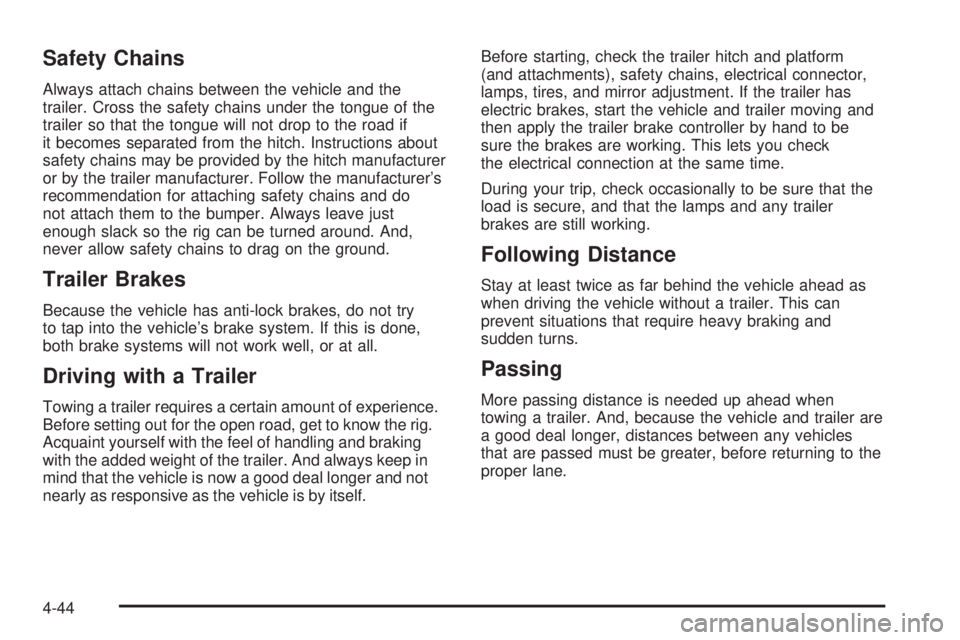
Safety Chains
Always attach chains between the vehicle and the
trailer. Cross the safety chains under the tongue of the
trailer so that the tongue will not drop to the road if
it becomes separated from the hitch. Instructions about
safety chains may be provided by the hitch manufacturer
or by the trailer manufacturer. Follow the manufacturer’s
recommendation for attaching safety chains and do
not attach them to the bumper. Always leave just
enough slack so the rig can be turned around. And,
never allow safety chains to drag on the ground.
Trailer Brakes
Because the vehicle has anti-lock brakes, do not try
to tap into the vehicle’s brake system. If this is done,
both brake systems will not work well, or at all.
Driving with a Trailer
Towing a trailer requires a certain amount of experience.
Before setting out for the open road, get to know the rig.
Acquaint yourself with the feel of handling and braking
with the added weight of the trailer. And always keep in
mind that the vehicle is now a good deal longer and not
nearly as responsive as the vehicle is by itself.Before starting, check the trailer hitch and platform
(and attachments), safety chains, electrical connector,
lamps, tires, and mirror adjustment. If the trailer has
electric brakes, start the vehicle and trailer moving and
then apply the trailer brake controller by hand to be
sure the brakes are working. This lets you check
the electrical connection at the same time.
During your trip, check occasionally to be sure that the
load is secure, and that the lamps and any trailer
brakes are still working.
Following Distance
Stay at least twice as far behind the vehicle ahead as
when driving the vehicle without a trailer. This can
prevent situations that require heavy braking and
sudden turns.
Passing
More passing distance is needed up ahead when
towing a trailer. And, because the vehicle and trailer are
a good deal longer, distances between any vehicles
that are passed must be greater, before returning to the
proper lane.
4-44
Page 287 of 444
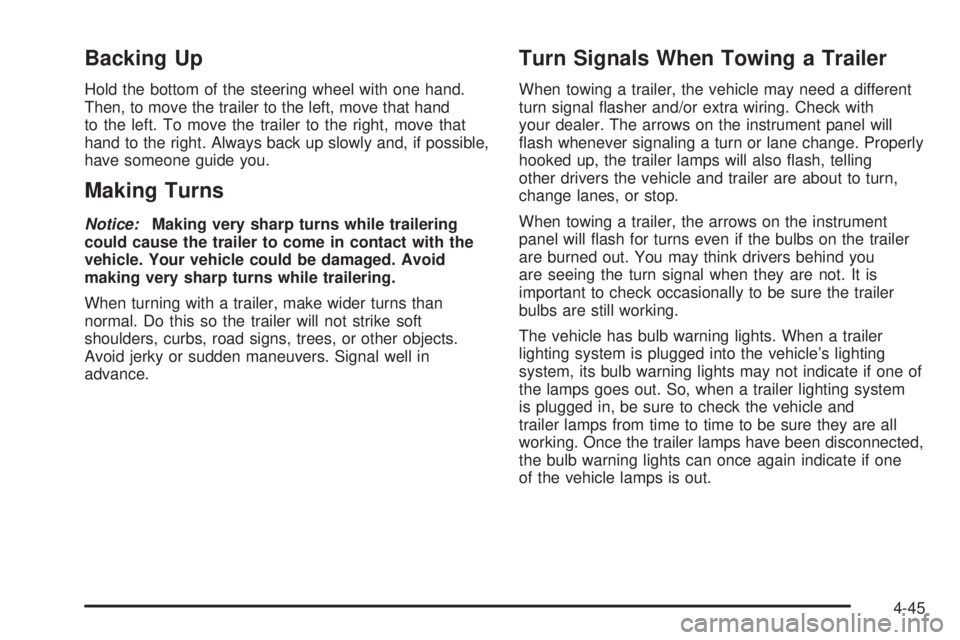
Backing Up
Hold the bottom of the steering wheel with one hand.
Then, to move the trailer to the left, move that hand
to the left. To move the trailer to the right, move that
hand to the right. Always back up slowly and, if possible,
have someone guide you.
Making Turns
Notice:Making very sharp turns while trailering
could cause the trailer to come in contact with the
vehicle. Your vehicle could be damaged. Avoid
making very sharp turns while trailering.
When turning with a trailer, make wider turns than
normal. Do this so the trailer will not strike soft
shoulders, curbs, road signs, trees, or other objects.
Avoid jerky or sudden maneuvers. Signal well in
advance.
Turn Signals When Towing a Trailer
When towing a trailer, the vehicle may need a different
turn signal �asher and/or extra wiring. Check with
your dealer. The arrows on the instrument panel will
�ash whenever signaling a turn or lane change. Properly
hooked up, the trailer lamps will also �ash, telling
other drivers the vehicle and trailer are about to turn,
change lanes, or stop.
When towing a trailer, the arrows on the instrument
panel will �ash for turns even if the bulbs on the trailer
are burned out. You may think drivers behind you
are seeing the turn signal when they are not. It is
important to check occasionally to be sure the trailer
bulbs are still working.
The vehicle has bulb warning lights. When a trailer
lighting system is plugged into the vehicle’s lighting
system, its bulb warning lights may not indicate if one of
the lamps goes out. So, when a trailer lighting system
is plugged in, be sure to check the vehicle and
trailer lamps from time to time to be sure they are all
working. Once the trailer lamps have been disconnected,
the bulb warning lights can once again indicate if one
of the vehicle lamps is out.
4-45
Page 289 of 444
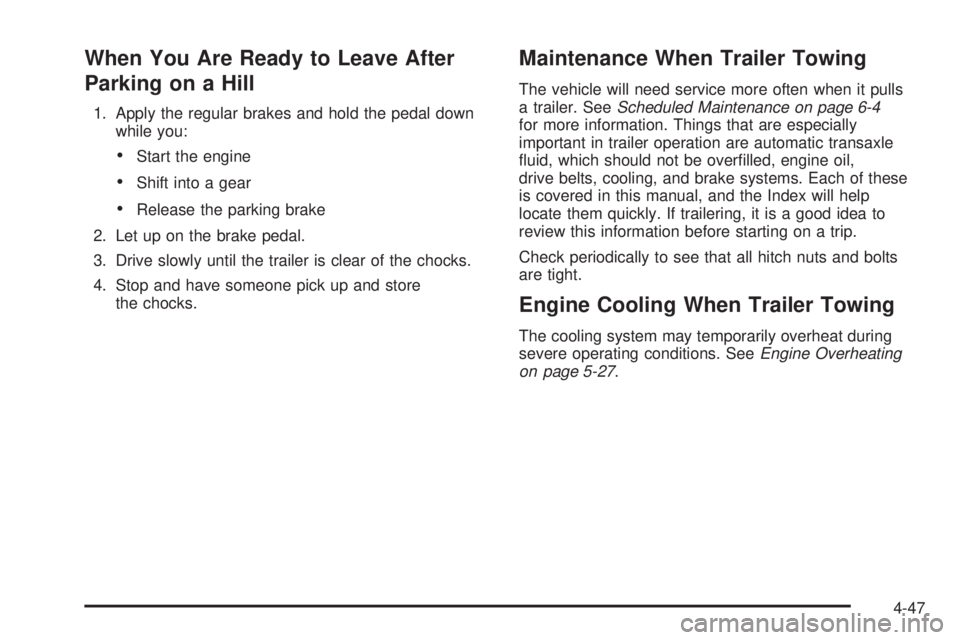
When You Are Ready to Leave After
Parking on a Hill
1. Apply the regular brakes and hold the pedal down
while you:
Start the engine
Shift into a gear
Release the parking brake
2. Let up on the brake pedal.
3. Drive slowly until the trailer is clear of the chocks.
4. Stop and have someone pick up and store
the chocks.
Maintenance When Trailer Towing
The vehicle will need service more often when it pulls
a trailer. SeeScheduled Maintenance on page 6-4
for more information. Things that are especially
important in trailer operation are automatic transaxle
�uid, which should not be over�lled, engine oil,
drive belts, cooling, and brake systems. Each of these
is covered in this manual, and the Index will help
locate them quickly. If trailering, it is a good idea to
review this information before starting on a trip.
Check periodically to see that all hitch nuts and bolts
are tight.
Engine Cooling When Trailer Towing
The cooling system may temporarily overheat during
severe operating conditions. SeeEngine Overheating
on page 5-27.
4-47
Page 304 of 444
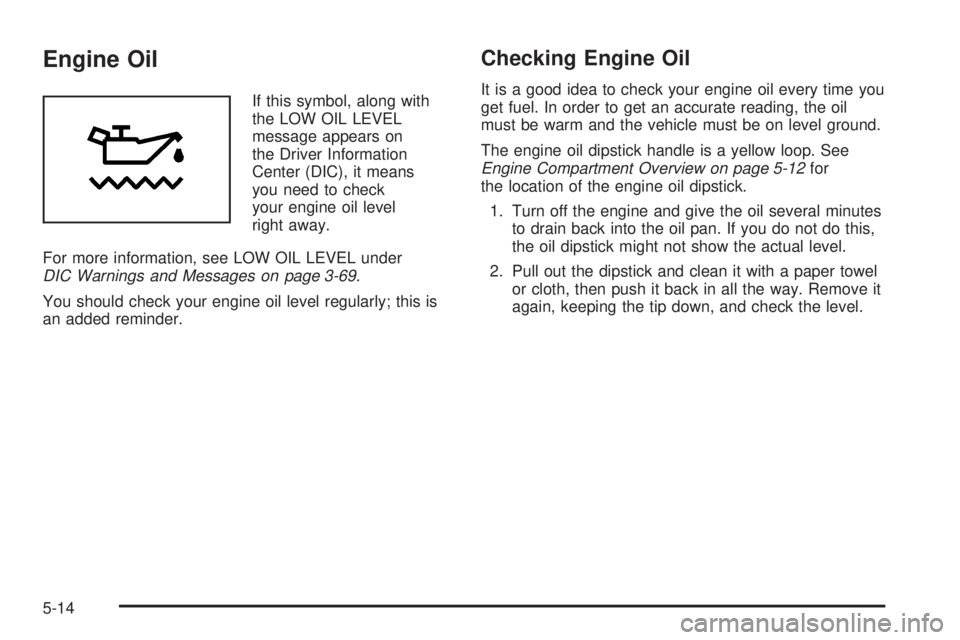
Engine Oil
If this symbol, along with
the LOW OIL LEVEL
message appears on
the Driver Information
Center (DIC), it means
you need to check
your engine oil level
right away.
For more information, see LOW OIL LEVEL under
DIC Warnings and Messages on page 3-69.
You should check your engine oil level regularly; this is
an added reminder.
Checking Engine Oil
It is a good idea to check your engine oil every time you
get fuel. In order to get an accurate reading, the oil
must be warm and the vehicle must be on level ground.
The engine oil dipstick handle is a yellow loop. See
Engine Compartment Overview on page 5-12for
the location of the engine oil dipstick.
1. Turn off the engine and give the oil several minutes
to drain back into the oil pan. If you do not do this,
the oil dipstick might not show the actual level.
2. Pull out the dipstick and clean it with a paper towel
or cloth, then push it back in all the way. Remove it
again, keeping the tip down, and check the level.
5-14
Page 311 of 444
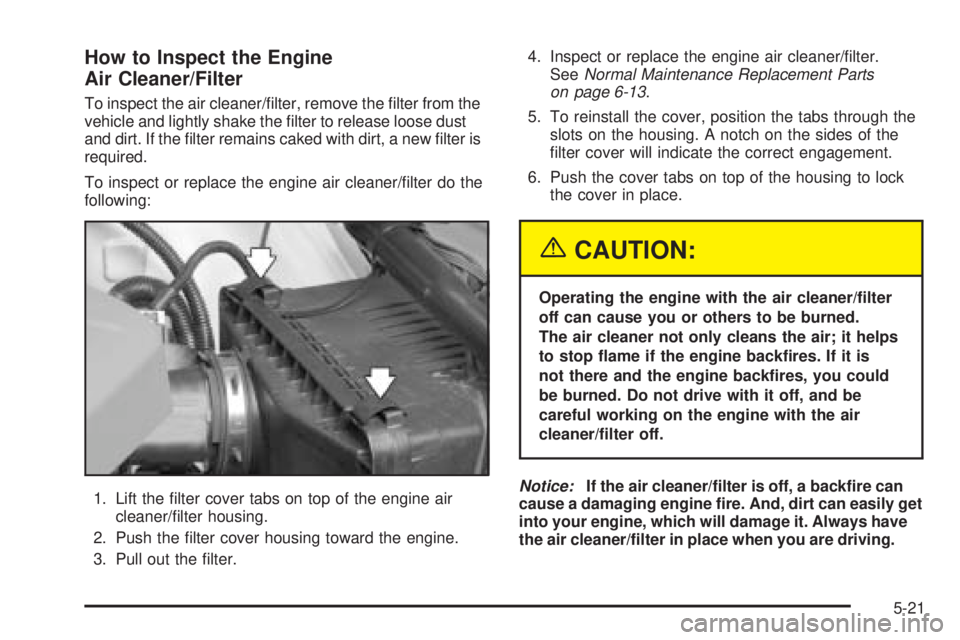
How to Inspect the Engine
Air Cleaner/Filter
To inspect the air cleaner/�lter, remove the �lter from the
vehicle and lightly shake the �lter to release loose dust
and dirt. If the �lter remains caked with dirt, a new �lter is
required.
To inspect or replace the engine air cleaner/�lter do the
following:
1. Lift the �lter cover tabs on top of the engine air
cleaner/�lter housing.
2. Push the �lter cover housing toward the engine.
3. Pull out the �lter.4. Inspect or replace the engine air cleaner/�lter.
SeeNormal Maintenance Replacement Parts
on page 6-13.
5. To reinstall the cover, position the tabs through the
slots on the housing. A notch on the sides of the
�lter cover will indicate the correct engagement.
6. Push the cover tabs on top of the housing to lock
the cover in place.
{CAUTION:
Operating the engine with the air cleaner/�lter
off can cause you or others to be burned.
The air cleaner not only cleans the air; it helps
to stop �ame if the engine back�res. If it is
not there and the engine back�res, you could
be burned. Do not drive with it off, and be
careful working on the engine with the air
cleaner/�lter off.
Notice:If the air cleaner/�lter is off, a back�re can
cause a damaging engine �re. And, dirt can easily get
into your engine, which will damage it. Always have
the air cleaner/�lter in place when you are driving.
5-21
Page 312 of 444
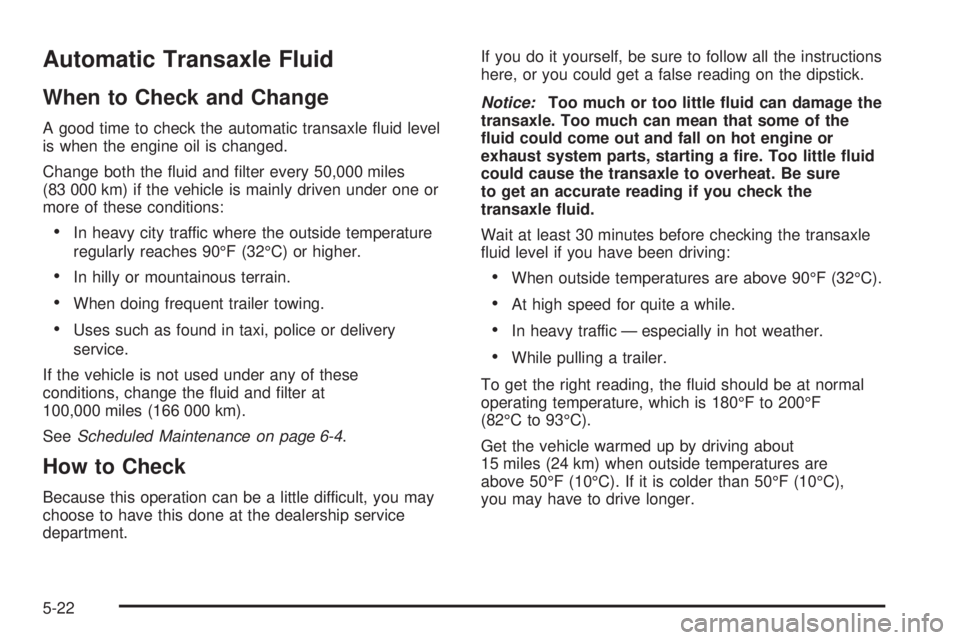
Automatic Transaxle Fluid
When to Check and Change
A good time to check the automatic transaxle �uid level
is when the engine oil is changed.
Change both the �uid and �lter every 50,000 miles
(83 000 km) if the vehicle is mainly driven under one or
more of these conditions:
In heavy city traffic where the outside temperature
regularly reaches 90°F (32°C) or higher.
In hilly or mountainous terrain.
When doing frequent trailer towing.
Uses such as found in taxi, police or delivery
service.
If the vehicle is not used under any of these
conditions, change the �uid and �lter at
100,000 miles (166 000 km).
SeeScheduled Maintenance on page 6-4.
How to Check
Because this operation can be a little difficult, you may
choose to have this done at the dealership service
department.If you do it yourself, be sure to follow all the instructions
here, or you could get a false reading on the dipstick.
Notice:Too much or too little �uid can damage the
transaxle. Too much can mean that some of the
�uid could come out and fall on hot engine or
exhaust system parts, starting a �re. Too little �uid
could cause the transaxle to overheat. Be sure
to get an accurate reading if you check the
transaxle �uid.
Wait at least 30 minutes before checking the transaxle
�uid level if you have been driving:
When outside temperatures are above 90°F (32°C).
At high speed for quite a while.
In heavy traffic — especially in hot weather.
While pulling a trailer.
To get the right reading, the �uid should be at normal
operating temperature, which is 180°F to 200°F
(82°C to 93°C).
Get the vehicle warmed up by driving about
15 miles (24 km) when outside temperatures are
above 50°F (10°C). If it is colder than 50°F (10°C),
you may have to drive longer.
5-22
Page 313 of 444
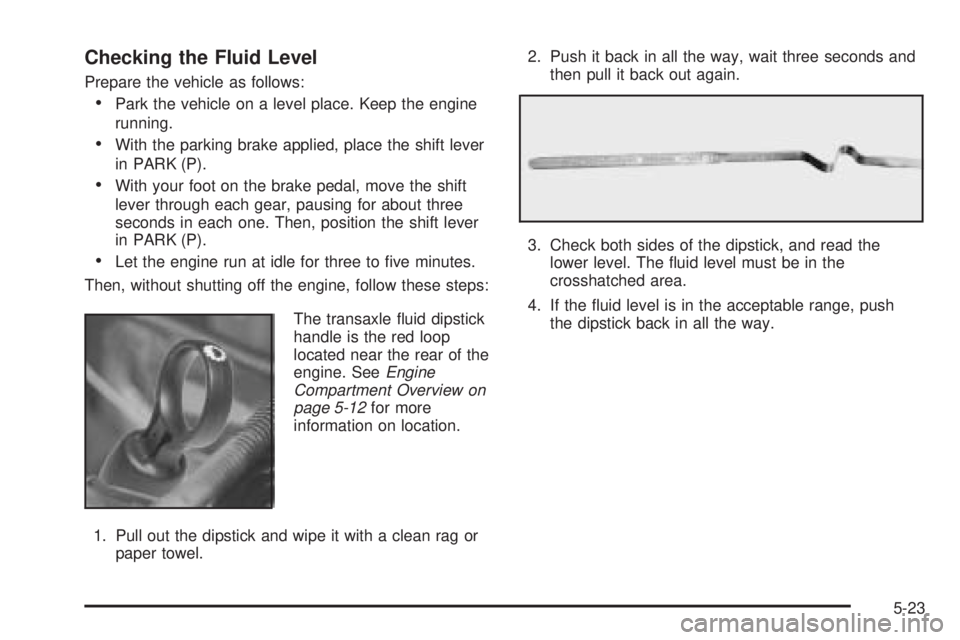
Checking the Fluid Level
Prepare the vehicle as follows:
Park the vehicle on a level place. Keep the engine
running.
With the parking brake applied, place the shift lever
in PARK (P).
With your foot on the brake pedal, move the shift
lever through each gear, pausing for about three
seconds in each one. Then, position the shift lever
in PARK (P).
Let the engine run at idle for three to �ve minutes.
Then, without shutting off the engine, follow these steps:
The transaxle �uid dipstick
handle is the red loop
located near the rear of the
engine. SeeEngine
Compartment Overview on
page 5-12for more
information on location.
1. Pull out the dipstick and wipe it with a clean rag or
paper towel.2. Push it back in all the way, wait three seconds and
then pull it back out again.
3. Check both sides of the dipstick, and read the
lower level. The �uid level must be in the
crosshatched area.
4. If the �uid level is in the acceptable range, push
the dipstick back in all the way.
5-23